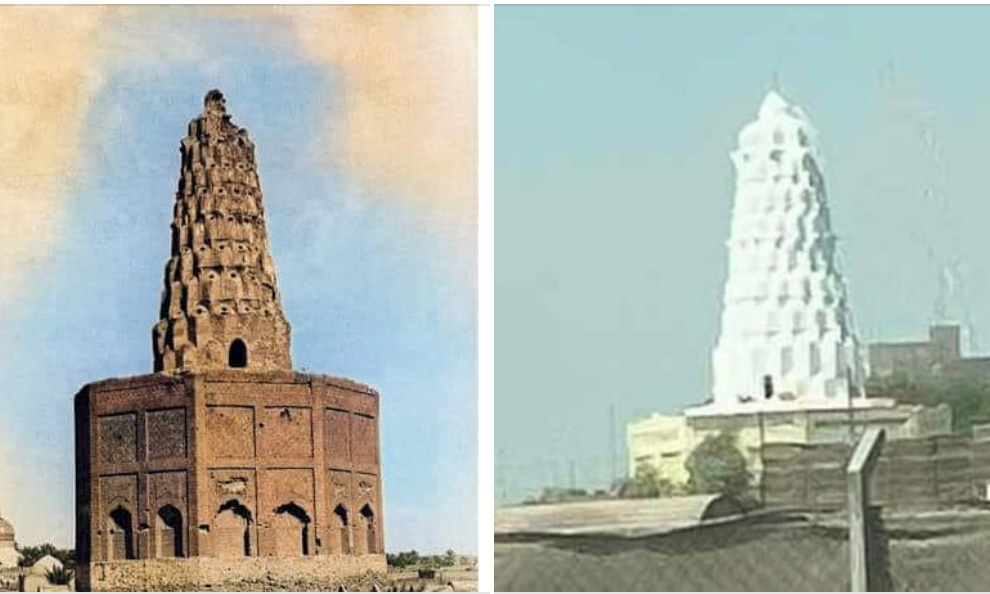The mosque and mausoleum, where Zumurrud Khatun herself is buried, before and after the restoration work
Photo: Yasir Mutlag Aljibury / Facebook
Heritage advocates have expressed outrage at restoration work on the Zumurrud Khatun Mosque and Mausoleum in Baghdad, claiming it has “ruined” the historic site. The striking brick minaret on the building, located within the Sheikh Ma'ruf cemetery in the western district of Karkh, has been covered in white plaster.
The mosque and mausoleum were commissioned by Zumurrud Khatun, the wife of a prominent Abbasid caliph and a figure known for her architectural patronage, along with her son at the beginning of the 13th century. The building, considered to be a rare architectural jewel of the Seljuk era, boasts an exquisite nine-layered conically shaped roof made of muqarnas or honeycombed vaulting, topped off by a cupola, and an elegant minaret of fine brickwork. It is a favourite pilgrimage site for Sufis from around the world.
The ceiling of the mausoleum from the inside
Photo: Hadani Ditmars
Over recent decades, however, like many other Iraqi heritage sites, the building has suffered due to the effects of UN sanctions and post-invasion violence and corruption. The carved wooden doors were destroyed by US soldiers in 2003, and after years of neglect the base of the tower has deteriorated.
When this correspondent visited the site in 2010, the keeper complained that any funds received from the State Board of Antiquities and Heritage (SBAH) were insufficient for its upkeep.
To complicate this further, the site has since has fallen victim to the sectarianisation of heritage in what is today a Shiah-dominated nation. While the Iraqi government has been keen to invest in conserving Shiah shrines, which attract millions of Iranian pilgrims a year and bring significant profits, Sunni sites—such as the historic Siraji minaret in Basra destroyed last year by local authorities engaged in road expansion—have not fared well.
In June, concerns reached new heights after initial excavation for the planned construction of a nearby highway began to damage the site. SBAH officials intervened, pledging to restore it. However, last week, it was revealed that as part of this work, the brick minaret had been enveloped in white plaster.
While heavy-handed reconstruction of ancient sites has long plagued Iraqi heritage—from Saddam Hussein’s damaging “restoration” of the ancient city of Babylon in the 1970s, through to the recent Disneyfication of Muttanabe Street in old Baghdad—this latest incident has shocked Iraqis working in the field.
“This is a farce!” said the Baghdad heritage activist Yasir Mutlag Aljibury on social media, referring to the site as an example of “rare Abbasid architectural art.”
“They ‘restored’ it, but they ruined it,” heritage activist Dhikra Sarsam, a founder of the Burjbabel (Tower of Babel) initiative—which works to protect Iraqi heritage—tells The Art Newspaper.
“It doesn’t look like a heritage site anymore,” she says. “It looks brand new.” Sarsam notes that while SBAH did fix cracks in the dome caused by the initial highway excavation, they removed the outer layer of the lower part of the dome for cosmetic reasons, “which will actually weaken the structure”.
The issue of the new highway being constructed in the area continues to threaten the site.
Sarsam recalls visiting the mausoleum in December of 2023, when plans for the new road were announced and the Ministry of Public Works issued a notice to local residents to exhume the graves of their relatives in the Sheik Ma’ruf cemetery. The cemetery is the oldest in Baghdad—home to the graves of important figures such as Ma’ruf Kharki, the Sufi mystic it is named after, as well as the legendary poet Abu Nawas and the famous mid-20th century singer Nadem al Ghazali.
During their trip, Sarasam and her group of heritage advocates documented the locals’ protest against this demand on social media, around the same time a fatwa—a ruling on a point of Islamic law—was issued by local clerics prohibiting the exhumation of bodies. The ministry subsequently announced it would build a bridge over the site instead of destroying the cemetery.
But as it has transpired, Sarasam says, the foundation of the new highway bridge— part of Iraqi prime minister Mohammed Shia' Al Sudani’s grand national plan to improve transportation infrastructure— is right in front of the Zumurrud Khatun shrine. It is a mere 10 metres from the entrance.
What is more, the highway, which is being built by a Chinese company, will bisect the old city of Baghdad. This, Sarsam says, is “against all heritage protocols.”
“The government was looking for the easiest and cheapest way,” Sarsam told The Art Newspaper. “They didn’t want to buy adjacent land as a buffer zone. They could have done it differently.”
How reversible any further damage caused to the site will be is unclear. Burjbabel had some limited success in securing repairs to the nearby Seljuk shrine to Omar al Suhrawardi— venerated by the Sufis who follow his school—in 2019.
“But it’s still not been restored completely,” Sarasam notes. “The money for repairs just disappeared.”

